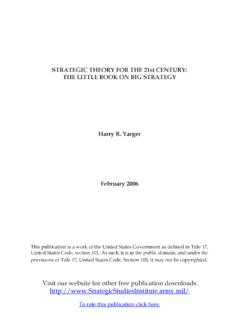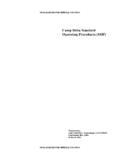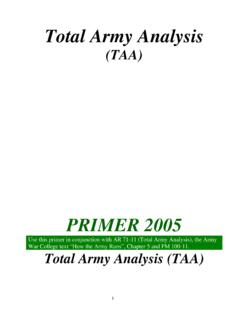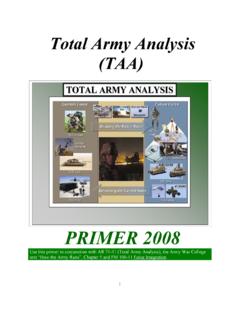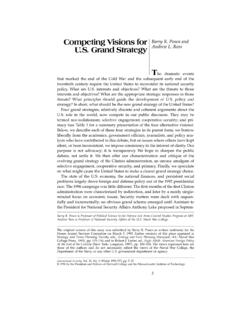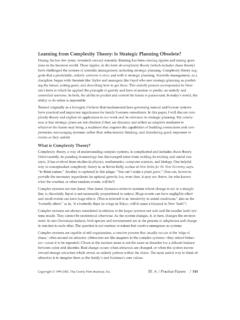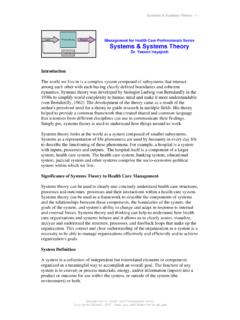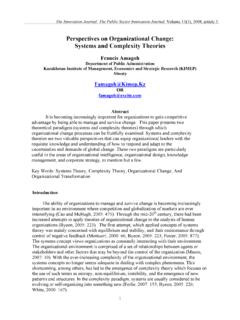Transcription of Strategic Theory for the 21st Century - comw.org
1 Strategic Theory FOR THE 21st Century :THE LITTLE BOOK ON BIG STRATEGYH arry R. YargerFebruary 2006 This publication is a work of the United States Government as defined in Title 17, United States Code, section 101. As such, it is in the public domain, and under the provisions of Title 17, United States Code, Section 105, it may not be our website for other free publication rate this publication click ** The views expressed in this report are those of the author and do not necessarily reflect the official policy or position of the Department of the Army, the Department of Defense, or the Government. This report is cleared for public release; distribution is unlimited.** Comments pertaining to this report are invited and should be forwarded to: Director, Strategic Studies Institute, Army War College, 122 Forbes Ave, Carlisle, PA 17013-5244. ** All Strategic Studies Institute (SSI) monographs are available on the SSI homepage for electronic dissemination.
2 Hard copies of this report also may be ordered from our homepage. SSI s homepage address is: ** The Strategic Studies Institute publishes a monthly e-mail newsletter to update the national security community on the research of our analysts, recent and forthcoming publications, and upcoming conferences sponsored by the Institute. Each newsletter also provides a Strategic commentary by one of our research analysts. If you are interested in receiving this newsletter, please subscribe on our homepage at 1-58487-233-0iiiCONTENTSF oreword ..vPreface ..viiSummary .. ixI. Introduction .. 1II. A Theory Stated: Strategy s Logic .. 5 III. The Strategic Environment .. 17IV. Theory in the Real World .. 31V. The Strategy Paradigm in Short: A Theory Restated .. 65VI. Concluding Thoughts .. 73 Endnotes .. 77 About the Author .. 83vFOREWORD The word strategy pervades American conversation and our news media. We tend to use strategy as a general term for a plan, a concept, a course of action, or a vision of the direction in which to proceed at the personal, organizational, and governmental local, state, or federal levels.
3 Such casual use of the term to describe nothing more than what we would like to do next is inappropriate and belies the complexity of true strategy and Strategic thinking. It reduces strategy to just a good idea without the necessary underlying thought or development. It also leads to confusion between strategy and planning, confining Strategic possibilities to near-time planning assumptions and details, while limiting the flexibility of Strategic thought and setting inappropriately specific expectations of outcomes. This little book actually a monograph talks about big strategy, strategy at the highest levels of the nation-state. It is applicable to grand strategy, national security strategy, national military strategy, and regional or theater strategy. The monograph does not propose a strategy for the United States; rather, it provides a framework for considering strategy at any of the levels mentioned above. It is an examination of Theory , exploring those aspects of strategy that appear to have universal application.
4 The Theory also may have application to the strategy of nonstate actors, institutions, and businesses, but the explicit purpose and perspective offered herein focus on the nation-state. This Letort Paper is written to expose emerging senior leaders and strategists at the Army War College to the vocabulary, ideas, and concepts that will enable them to construct a framework for developing their own Strategic perspective of the trends, issues, opportunities, and threats confronting the United States in the 21st C. LOVELACE, Studies Institute viiPREFACE This monograph has been constructed by borrowing freely from the ideas and concepts of others, some of whom have global recognition and others who toiled namelessly as faculty members and students at various senior service colleges. I apologize to all for those instances wherein I may have misrepresented their ideas or paraphrased too closely without proper recognition in my quest for a synthesis of thought that might qualify as pure Theory .
5 I also apologize to readers for the frequent redundancy and complexity of my work but strategy is a complex thing that is better understood when examined from different perspectives. In the same light, I have used examples very sparingly and reluctantly, only as a means to indicate the path of my thinking. To do more would beg for the illustration to be challenged instead of the thought, or suggest the direct application of the lessons of the example to similar circumstances. A Theory of strategy is neither a simple checklist nor a cookbook solution. It is a way to understand how you might develop a perspective and approach for defining and selecting alternative choices in an increasingly complex and rapidly changing world focusing on how to think as opposed to what to think and articulating your choices in ways that can be understood and implemented. Strategy is neither simple nor easy, but the good strategist seeks to express the logic of strategy in the simplest, clearest Strategy for the nation-state is neither simple nor easy.
6 Good strategy demands much of the military professional whether he is formulating, articulating, evaluating, or executing strategy. Few do it well. It requires the professional to step out of the planning mindset and adopt one more suited for the Strategic environment. This is particularly true in periods of great change and turmoil when a successful military strategy must be closely integrated with and may depend on other national strategies of the interagency community. A Theory of strategy helps in this transition by educating the professional and disciplining his thinking in any of his roles. This monograph advances a Theory of strategy that provides essential terminology and definitions, explanations of the underlying assumptions and premises, and substantive hypotheses that explain the nature of the Strategic environment and the role and expectations of strategy. The environment is explained in theoretical and practical terms, and the implications for Strategic thinking are developed with a distinction being made between strategy and planning mindsets.
7 The typical problems practitioners have in formulating and articulating strategy are discussed. Strategy formulation is recognized as both an art and science, and the Army War College strategy model of ends, ways, and means is expounded on and advocated as a methodology for articulating INTRODUCTIONLike politics, strategy is the art of the possible; but few can discern what is Murray and Mark Grimsley In simplistic terms, strategy at all levels is the calculation of objectives, concepts, and resources within acceptable bounds of risk to create more favorable outcomes than might otherwise exist by chance or at the hands of others. Strategy is defined in Joint Publication 1-02 as the art and science of developing and employing instruments of national power in a synchronized and integrated fashion to achieve theater, national, and/or multinational objectives. 2 Both of these definitions are useful, but neither fully conveys the role and complexity of Strategic thought at the highest levels of the state.
8 At these levels, strategy is the art and science of developing and using the political, economic, social-psychological, and military powers of the state in accordance with policy guidance to create effects that protect or advance national interests relative to other states, actors, or circumstances. Strategy seeks a synergy and symmetry of objectives, concepts, and resources to increase the probability of policy success and the favorable consequences that follow from that success. It is a process that seeks to apply a degree of rationality and linearity to circumstances that may or may not be either. Strategy accomplishes this by expressing its logic in rational, linear terms ends, ways, and means. Strategy is far from simple, and understanding a Theory of strategy allows us to grasp and work with its complexity by understanding its logic. A Theory of strategy provides essential terminology and definitions, explanations of the underlying assumptions and premises, substantive propositions translated into testable hypotheses, and methods that can be used to test the hypotheses and modify the Theory as Why study a Theory of strategy?
9 Theory s value lies not in a prescription for success but in how it helps us expand and discipline our thinking. As Clausewitz reminds us, Theory should be for study, not doctrine. 2 Theory then becomes a guide to anyone who wants to learn about war from books; it will light his way, ease his progress, training his judgment, and help him to avoid pitfalls.. Theory exists so that one need not start afresh each time sorting out the material and plowing through it, but will find it ready to hand and in good order. It is meant to educate the mind of the future commander..4A Theory of strategy educates the strategist s mind. It helps discipline our thinking in order to deal with the complexity and volatility of the Strategic environment and the changes and continuities, issues, opportunities, and threats inherent to it. It encourages us to rethink our own assumptions and prejudices, but it also encourages us to consider the possible assumptions and prejudices of our adversaries and other actors.
10 Strategic Theory opens the mind to all the possibilities and forces at play, prompting us to consider the costs and risks of our decisions and weigh the consequences of those of our adversaries, allies, and others. On another level, Theory allows the members of the military profession and the interagency community to communicate intelligently in regard to strategy. It serves as a common frame of reference for the development and evaluation of an appropriate strategy and the communication of it to those who must implement it. A disciplined Theory of strategy also allows the professional to evaluate the merits of a particular strategy and critique it in meaningful terms for those who determine policy and make decisions. Strategic thinking is difficult. It is best viewed as both an art and a science. The framework of Theory provides a methodological basis for a disciplined thought process to assist the strategist in developing strategy, and it also serves as a guide for others to follow in comprehending, evaluating, and critiquing the merits of a particular strategy.
